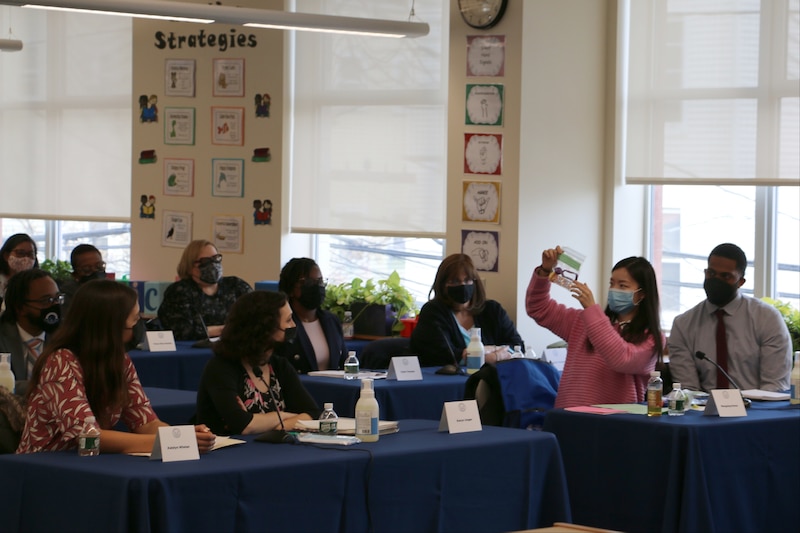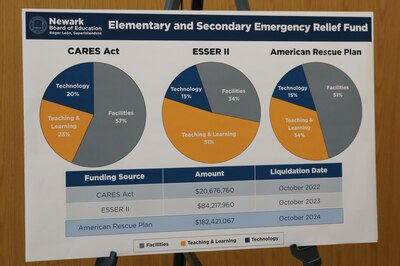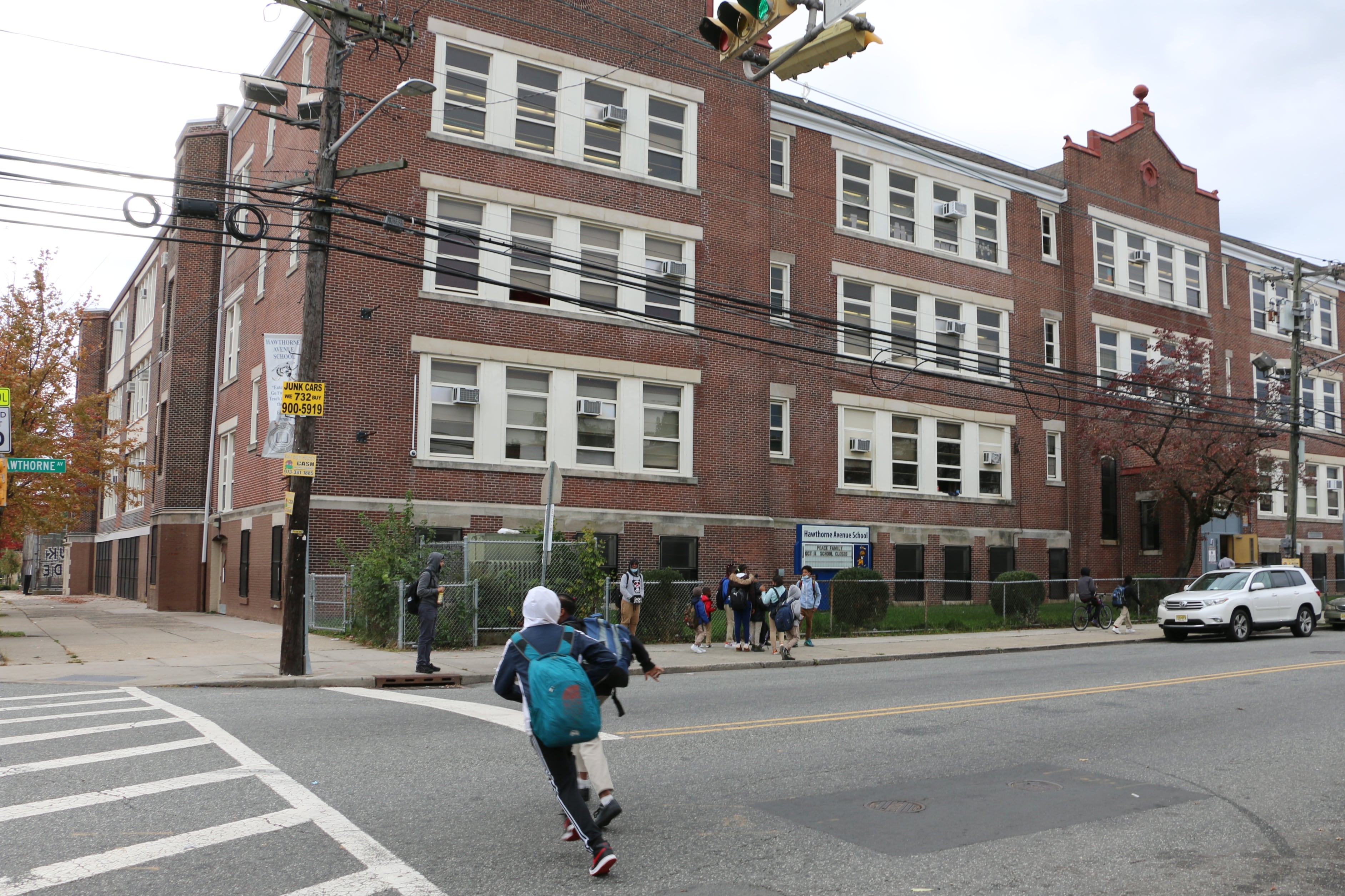How are Newark schools spending the $182 million windfall they’re receiving in the final round of federal COVID aid?
Abington Avenue School purchased laptops for each of its nearly 100 kindergarteners, who previously shared a set of 32 devices. Park Elementary School replaced worksheets with hardware, including model dinosaur bones for inspecting and ice cream scoops for measuring, so students can learn by doing. And First Avenue School expanded and revamped its after-school program, where students receive tutoring, food, and enrichment activities like yoga.
“As you can see, the children of Newark are benefiting from these dollars,” said Janice Litterio, an academic interventionist at First Avenue, during an event last month where Newark educators shared how the federal money has helped their schools.

But the district’s plan also raises questions about priorities, with the majority of the aid going to building repairs and technology and only a third earmarked for teaching and learning. Despite data showing the pandemic severely disrupted students’ learning, the spending plan sets aside more money for office computers than tutoring.

In total, Newark Public Schools is set to receive more than $287 million from the three relief packages that Congress has approved since 2020 to help schools respond to the pandemic, reopen classrooms, and support students’ emotional and academic recovery.
That colossal sum is equivalent to nearly a third of the district’s annual budget, and is eight times the amount of federal aid the district received in the school year before the pandemic. The money equals about $7,560 extra for each of the district’s roughly 38,000 students; right now, the district budget includes nearly $20,000 per student.
In February, the state approved Newark’s spending plan for the $182.4 million, which includes a $177 million grant from the federal government as well as subgrants from the state to support teacher training, summer and after-school programs, and student mental health. The district has until October 2024 to obligate the money.
District officials previously shared a rough breakdown of their plan for the third aid package: 51% for facility upgrades, 34% for teaching and learning, and 15% for technology. Their strategy is to invest in building projects, devices, and staff training that will hopefully continue to pay dividends long after the money runs out.
“Our strategy is not to spend those dollars on a short-term reality, like the hiring of somebody,” Superintendent Roger León said during a recent school board meeting. “While the funds are allocated for a certain time period, we want to make sure the efforts last longer.”
Newark’s 128-page spending plan for the final installment of federal COVID money shows how the district intends to stretch those dollars. Chalkbeat analyzed the plan — here’s what we found.
Buildings will get a major makeover
Nearly $86 million, or almost half the total, will fund improvements to the district’s aging school buildings.
“The district schools are in poor to fair condition and many buildings have aged out of useful life,” the plan says. But because replacing the schools is too costly, the only option is “continued usage.”
The plan doesn’t list all the expected upgrades, but says some older buildings must be renovated to meet current safety standards, most schools need repainting, and “roofs, windows, gymnasiums, outdoor fields, and other areas” that have suffered water damage must be repaired or replaced.
Another $3.1 million will pay for new furniture for classrooms and science labs.
Just 5% of the funds are earmarked for tutoring
The pandemic dealt a crushing blow to student learning. In Newark, recent mid-year tests showed that the vast majority of students are far behind in math and reading.
The American Rescue Plan, the federal law that provides the third and most recent round of pandemic aid for schools, says districts must spend at least 20% of their allotment on “evidence-based interventions” to address learning loss. The U.S. Department of Education has suggested possible interventions, including summer programs and longer school days, but left the decision-making to districts.
The main way Newark says it will jumpstart student learning is by purchasing nearly $21 million worth of classroom supplies, including $9.4 million for textbooks and about $300,000 for materials for students with disabilities and English learners. The district also paid teachers to help with curriculum writing.
“The experience has inspired me,” said Karen Unger, a math teacher at Ann Street School who worked on new high school math materials. “I think I’ve become a better teacher as a result of it.”
Roughly $16 million will go towards enrichment activities, including field trips, and at least $9.8 million will fund staff training on special education, reading instruction, counseling, and other activities.
One intervention many experts recommend is intensive tutoring. U.S. Secretary of Education Miguel Cardona recently urged schools to give every struggling student 90 minutes of tutoring per week, and Newark’s superintendent says every school offers tutoring.
However, the spending plan only earmarks $9.3 million, or about 5% of the total American Rescue Plan aid, specifically for tutoring. That is slightly less than the $10 million the district set aside for new computers for office employees.
The plan also includes two state grants, worth about $586,000 total, for summer learning and afterschool programs.
Thomas Kane, an economist at the Harvard Graduate School of Education, said the recent test scores are a clear sign the district should invest heavily in direct support for struggling students.
“They ought to be planning to spend almost all of those federal dollars on academic recovery,” he said.
Tech, career education, and mental health round out the list
Newark will spend more than $27 million, or about 15% of the aid, on technology.
The tech includes tablets for younger students, classroom smart boards, and upgraded internet infrastructure for schools.
At least $3 million will go towards the recently revamped vocational programs in the district’s high schools, where students are introduced to careers in business, medicine, fashion, the culinary arts, and more. The money will help pay for supplies, field trips, and other expenses.
Just under $2 million will help pay for mental health support for students, including stipends for counselors and social workers, as well as staff training.
After the pandemic turned their lives upside down, separating students from friends and teachers and piling hardships on many families, the return to school has been tough on many students, the plan says.
Some are struggling with “relationship skills, self-management, and personal decision-making,” leading to an increase in behavior issues, the plan adds. Discipline data for this school year are not available, but León has said that “students are exhibiting behaviors unlike ever before.”
Students are showing more “symptoms of isolation, depression, lack of attentiveness,” the plan added, “and an overall decline in mental health.”
Patrick Wall is a senior reporter for Chalkbeat Newark, covering public education in the city and across New Jersey. Contact Patrick at pwall@chalkbeat.org.






